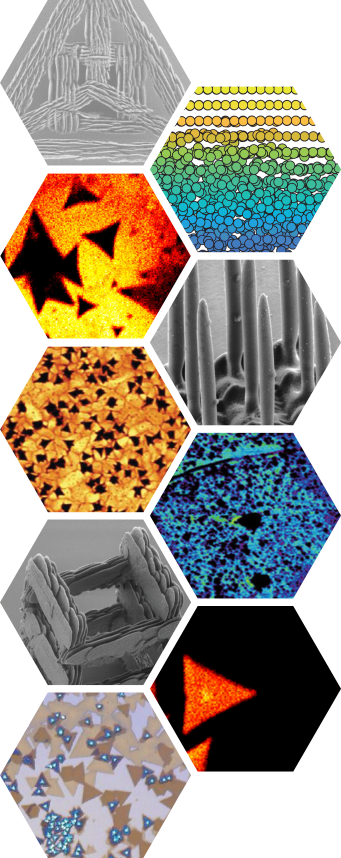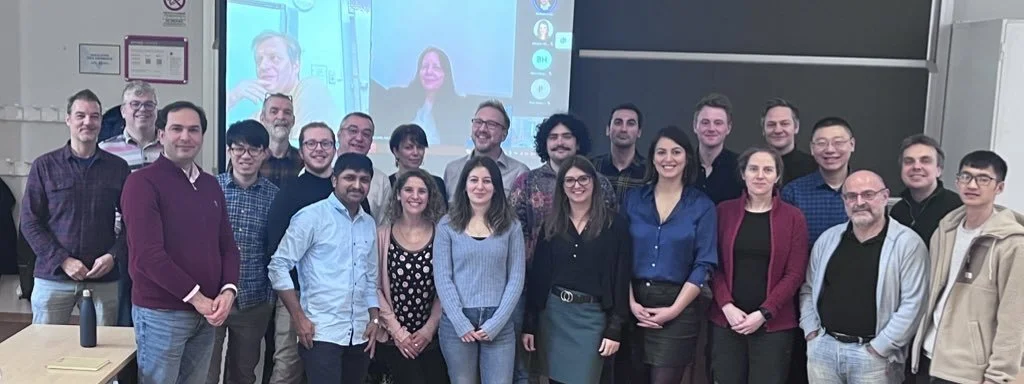Project Summary
Friction and wear between moving parts account for about 25% of global energy use. At SSLiP, we're developing a groundbreaking way to reduce friction using advanced materials.
Our approach is based on a phenomenon called structural superlubricity—a state of ultra-low friction seen at the atomic level. So far, this has only worked in lab settings on tiny scales. SSLiP aims to scale it up for real-world use.
We do this using tribo-colloids: tiny particles coated with special 2D materials. These particles form a dynamic network that mimics superlubricity on larger surfaces, even those that are rough or uneven.
By carefully designing the particles, coatings, and fluids they move in, we can control how they behave and even regenerate the coatings during use. Our research combines lab experiments, real-time imaging, and computer simulations to turn this concept into practical technology.
| 4 years | 7 partners | €4.4 million |
Our Objectives
1
Build Superlubric Structures
Create the building blocks of a friction-reducing network using 2D-coated particles.
2
Test Single Contact Superlubricity
Measure how well individual particle contacts reduce friction.
3
Scale Up to Real-World Conditions
Test how the full network performs in standard, large-scale friction tests.
4
Demonstrate a Working System
Show a complete, working lubricant system that uses this new technology at the macroscale.
Our Articles
V. H. Ho, M. M. Gianetti, A. Uluca, A. D. Sinnott, B. Haugen, G. L. Cross, and A. S. de Wijn. “A Theoretical Study on Friction of Macroscale Patterned Surfaces: Implications for Scaling Up Superlubricity.” ACS Applied Materials & Interfaces, 17(40), September 2025.
E. Kurban, D. Vescovi, and D. Berzi. "Crystallization in Load-Controlled Shearing Flows of Monosized Spheres." Soft Matter, 21(11), January 2025.
P. M. Zubieta-Laborde, Y. Long, T. Lubrecht, G. L. W. Cross, F. Dubreuil, J. M. Martin, and M. I. D. B. Bouchet. "Hypericin Enhances Superlubricity of Glycerol by Acting as Graphene Precursor." Friction (清华大学出版社), 13(1), January 2025.
D. D. Kumar, K. Kirubaharan, K. Panda, P. Kuppusami, A. Arivarasan, T. Stimpel-Lindner, and G. S. Duesberg. "Low Friction Characteristics and Tribochemistry Analysis of Novel AlTiN/a-C Based Nanocomposite Coatings." Applied Surface Science, 678(30), December 2024.
D. Vescovi, A. S. d. Wijn, G. L. W. Cross, and D. Berzi. "Extended Kinetic Theory Applied to Pressure-Controlled Shear Flows of Frictionless Spheres Between Rigid, Bumpy Planes." Soft Matter, 20, October 2024.
P. Huang, S. Chen, O. Hartwig, D. E. Marschner, G. S. Duesberg, G. Stemme, J. Li, K. B. Gylfason, and F. Niklaus. "3D Printing of Hierarchical Structures Made of Inorganic Silicon-Rich Glass Featuring Self-Forming Nanogratings." ACS Nano, 18(43), October 2024.
C. Bartlam, N. Saigal, S. Heiserer, H. Lambers, U. Wurstbauer, and G. S. Duesberg. "Orientation Dependent Interlayer Coupling in Organic-Inorganic Heterostructures." Advanced Functional Materials, 34(28), July 2024.
S. Heiserer, P. Eder, C. Ó Coileáin, J. Biba, T. Stimpel-Lindner, C. Bartlam, U. Rührmair, and G. S. Duesberg. "Controllable and Reproducible Growth of Transition Metal Dichalcogenides by Design of Experiments." Advanced Electronic Materials, 9(10), October 2023.
R. Dong, A. Lunghi, and S. Sanvito. "Stiffness and Atomic-Scale Friction in Superlubricant MoS₂ Bilayers." The Journal of Physical Chemistry Letters, 14(26), June 2023.
P. Huang, M. Laakso, P. Edinger, O. Hartwig, G. S. Duesberg, L. Lai, J. Mayer, J. Nyman, C. Errando-Herranz, G. Stemme, K. B. Gylfason, and F. Niklaus. "Three-Dimensional Printing of Silica Glass with Sub-Micrometer Resolution." Nature Communications, 14(1), June 2023.
R. Tilmann, C. Bartlam, O. Hartwig, B. Tywoniuk, N. Dominik, C. P. Cullen, L. Peters, T. Stimpel-Lindner, N. McEvoy, and G. S. Duesberg. "Identification of Ubiquitously Present Polymeric Adlayers on 2D Transition Metal Dichalcogenides." ACS Nano, 17(11), May 2023.
Contact us
Interested in working together? Fill out some info and we will be in touch shortly. We can’t wait to hear from you!



